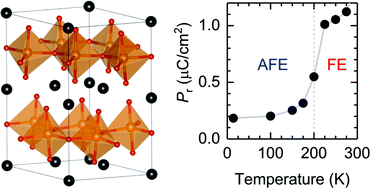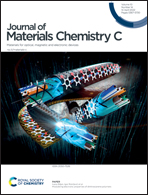Antiferroelectric-to-ferroelectric phase transition in hexagonal rare-earth iron oxides†
Abstract
Ferroic oxides often exhibit exotic behavior, accompanied by phase transitions. Hexagonal rare-earth iron oxides (h-RFeO3), a promising multiferroic system, have been reported to exhibit ferroelectricity (FE) when the lattice parameter ratio (c/a) exceeds 1.93 and antiferroelectricity (AFE) when c/a is equal to 1.89. Although the AFE–FE phase boundary in the h-RFeO3 systems is assumed to exist at c/a ≈ 1.9, the phase transition has not been observed so far due to the lack of samples with such a c/a ratio. In this study, we show the AFE–FE phase transition in h-RFeO3 films, where R = Dy. We fabricated h-DyFeO3 films with c/a ratios of 1.90–1.92 by controlling the film thicknesses. The h-DyFeO3 films with a c/a ratio of 1.91 exhibited AFE at temperatures below 200 K and FE at temperatures up to 300 K. The phase transition temperature (Tp) was modulated by the c/a ratio. The films also underwent an AFE–FE phase transition upon adjusting the frequency of the voltage applied at the Tp. We discuss the possible origin of the AFE–FE phase transition from the viewpoint of the migration length of the FE domain wall motion.



 Please wait while we load your content...
Please wait while we load your content...